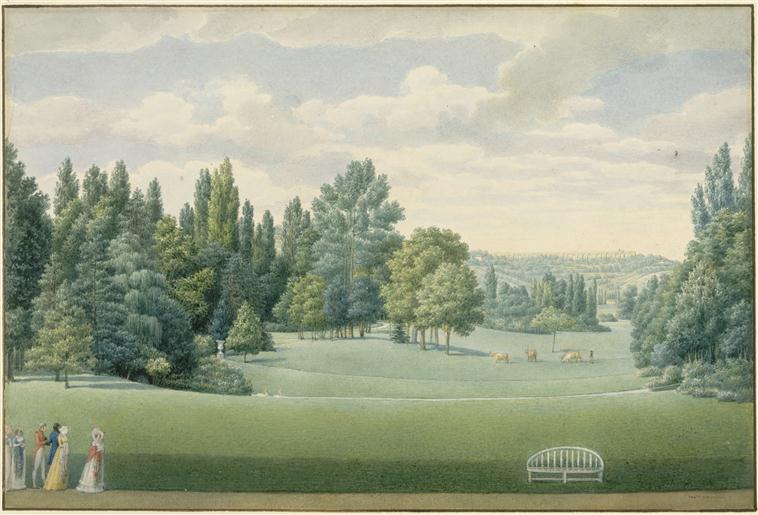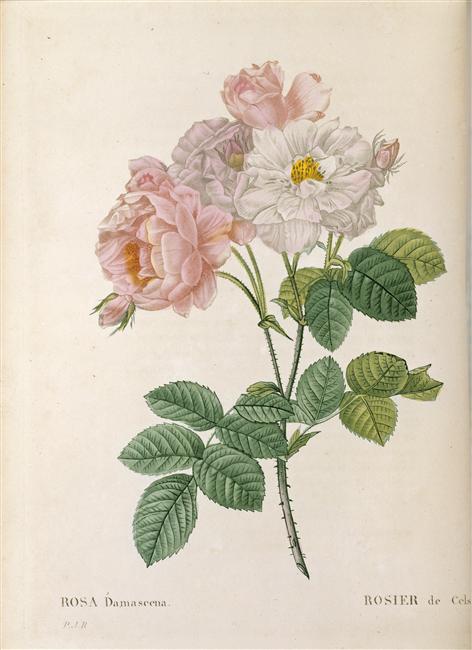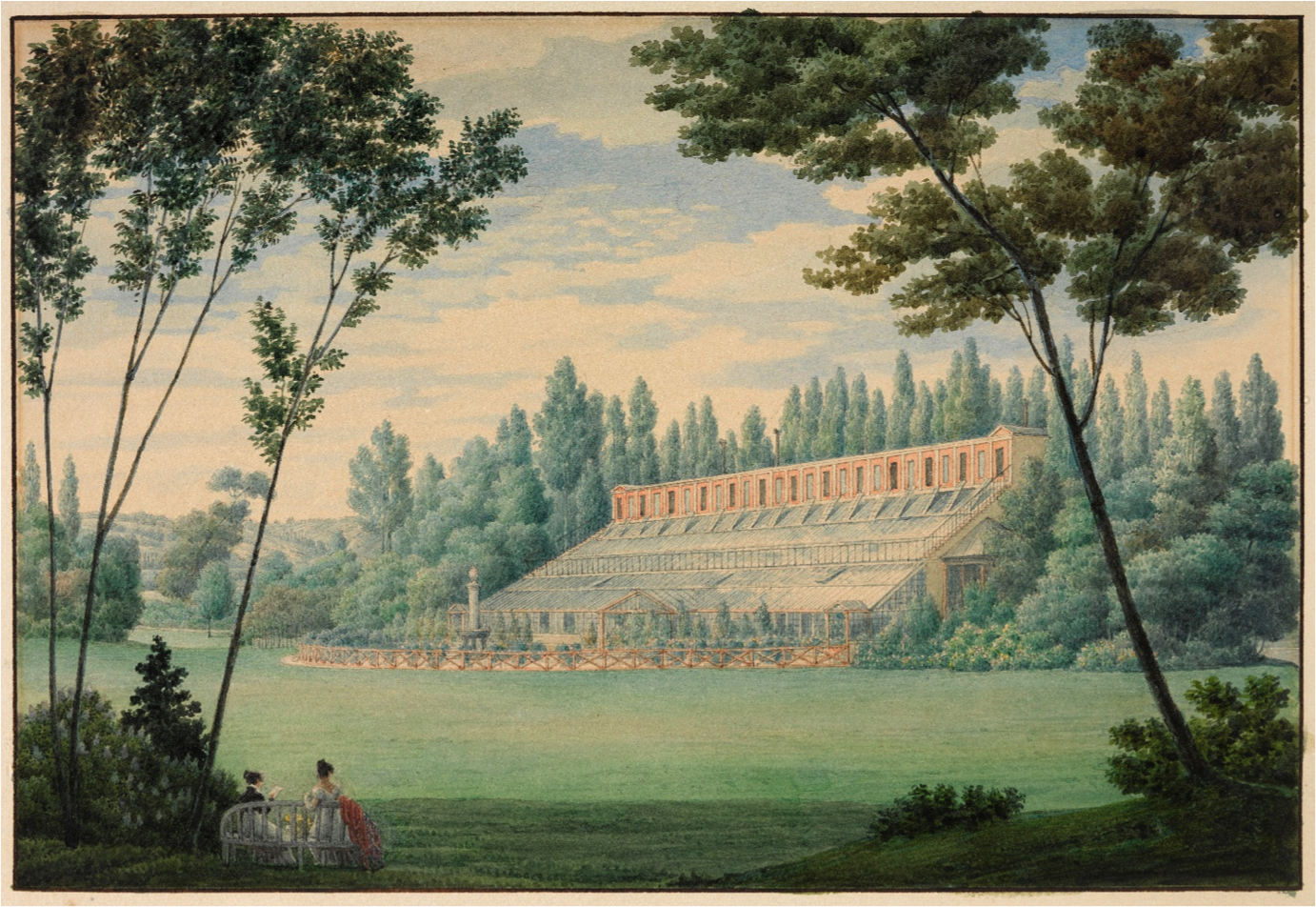
To breathe new life into the park she initially placed her trust in the architects Percier and Fontaine, who began fencing it off in 1801 then erected large stables, guard pavilions, a cavalry picket and a metal gate on the main path. Their plans for the botanical garden however, composed of greenhouses and an aviary, were not to her liking; Joséphine considered them too classical for her personal taste which tended more towards English gardens. Their successor Jean-Marie Morel, known as the “patriarch of English gardens", began the construction of a vast greenhouse, followed by a Swiss chalet in the park and three houses on the edge of the Saint-Cucufa pond which were to serve as a cow shed, a dairy and a house for the dairy farmer couple she brought to the estate from Switzerland. The large greenhouse was completed in 1805 by a different pair of architects, Thibault and Vignon, who also built a sheepfold to house the flock of merino sheep that were kept to provide enough wool for military uniforms and to set an example for other Imperial sheepfolds.
They were succeeded by Berthault, who understood Joséphine’s tastes perfectly and who remained in her service until the end of her life. Berthault completely reshaped the 70 hectares of enclosed parkland and interspersed it with constructions such as a the Temple of Love, a sepulchral monument to Melancholy, a grotto formed from rocks transported from Fontainebleau and a pool ornamented with a statue of Neptune. He cleared the view from the château by integrating existing monuments such as the Marly aqueduct and the Château de Saint Germain thus creating a "landscape park" and the atmosphere desired by the sovereign. The winding river in the middle of the lawn was widened to form a small navigable lake leading up to the large hot greenhouse which was finally completed, surpassing every other construction in its field at the time. The 50-metre long greenhouse was built alongside a building housing salons which also served as a gallery for the collection of Greek vases and plants. Heated by large coal stoves, its exceptional size meant that it could accommodate trees up to 5 metres high beneath its massive glass canopy.

Joséphine endeavoured to cultivate rare plants in her greenhouse and acclimatise the exotic flora she imported from Europe and beyond thanks to her relations with botanists, nursery growers and experts from the French Museum of Natural History. Maritime expeditions like the voyage undertaken by Captain Baudin brought her new plants and seeds to enrich her test garden which she took great delight in sharing with other gardening devotees. Some 200 plants were grown in France for the first time at Malmaison, such as purple magnolia, tree peony, hibiscus, camellias and dahlias. She also collected more than 250 varieties of rose, which were planted as bushes in the park or in pots to be moved outside in June. At Joséphine's request, the renowned illustrator P.J. Redouté, who was appointed flower painter to the Empress in 1805, produced 120 plates depicting the most beautiful plants at Malmaison published under the title "Le Jardin de Malmaison" (The Garden at Malmaison). She also encouraged him to produce the work on roses that would make him famous.
Joséphine’s passion for the natural sciences was by no means a passing fancy and also led her to take an interest in zoology; she attempted to introduce rare animals to the park such as black swans from Australia. Her menagerie even earned her a certain reputation and live animals were sent to her from Europe, Africa, America and Australia: ostriches, emus, kangaroos, orang-utans, zebras and numerous species of birds including parrots. However, specialised staff were required to take care of these animals which entailed considerable expense, so as of 1805 some of the animals were transported to the Museum and the Empress turned her attention back to botany. The plants did not survive for long after her death in 1814 with no one to tend to them, and the 726 hectares of the estate were gradually divided into parcels. Today the 6-hectare park still reflects the Empress’ passion thanks to the reintroduction of plants that grew there in her time, the prominent display of monuments and the views of the landscape that have been preserved.
When Napoleon III, son of Hortense, bought the estate from the Queen of Spain in 1861, he was greeted with an empty home. His first concern was to reconstruct the Empress' chamber using authentic documents, then the restoration and refurnishing of the apartments on the ground floor using the Garde-Meuble of the throne. A retrospective exhibition was organised, thus entailing the latest adjustments and allowing the paintings, busts and souvenirs from Saint Helena on loan from private collectors to be displayed.
In 1870, Malmaison passed from the hands of the Crown Estate to the State, but troops where stationed at the château until the end of the war. The estate was sold in 1877. In 1896, Daniel Iffla, known as Osiris, purchased the château which was listed for sale. He thus undertook the restoration of this ruined estate and took a great interest in restoring the decor in the apartments. On the first floor he removed the partitions between the chambers as they had been badly damaged and instead created vast exhibition rooms. He donated the estate to the French State which opened a museum in the property in 1905. His personal collection, which was bequeathed to the new museum, is exhibited in the pavilion named after him at the entrance to the park.
The first museum collection was composed of furniture amassed by Napoleon III and conserved by the Mobilier National. Many other pieces relating to the two Empires were added to the collections through donations. Transformed into a national museum in 1927, its very rich collections from the Second Empire were transferred to the Château de Compiègne in 1953 where they formed the basis for the Second Empire Museum, while the works from the First Empire were sent to the Château de Fontainebleau in 1984 to create the Napoleon I Museum.
Today, the Musée National des Châteaux de Malmaison et de Bois-Préau also includes the sites of Île-d'Aix and the Maison Bonaparte in Ajaccio, which together form a key Napoleonic museum collection. The museum arrangement is as follows: Malmaison houses all of the pieces relating to Joséphine and her children Eugène and Hortense, as well as Bonaparte as General and the First Consul. Bois-Préau is the home of the Napoeonic period from 1815 to today. The collections from the Second Empire are housed at the Château de Compiègne, while those from the First Empire are found at the Château de Fontainebleau. The Île-d'Aix, also a national museum, presents a rich collection on the Napoleonic era and legend as well as Napoleon's short stay on the island before his exile to Saint Helena. The Maison Bonaparte in Ajaccio is the family home where Napoleon was born on 15 August 1769, and which was refurbished by his mother Letizia Ramolino after 1797.

